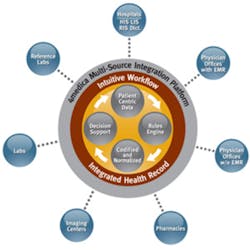A multi-source SaaS platform combines labs, meds and hospital records to offer more to improve the quality-of-care coordination and patient safety than a traditional EMR.
The IHR shares a common platform between its different components such as lab and radiology ordering and results, electronic prescribing, and hospital results and other documentation, making it easier to correlate a patient's data and present it at the point of care. When combined with the ability to normalize data from multiple sources, and easily access it over the Web, the IHR enables providers to benefit from a more complete, patient-centered record that transcends disconnected data silos and provides a unified, continuously updated view of each patient-care episode.
While the IHR can be used on its own, it also can be used to augment an existing EMR system by providing connectivity. In addition, the IHR can be used for patient referrals and is capable of supporting the continuity of care document (CCD), a standard format for data exchange among healthcare providers and HIEs. Interfaces with practice-management systems also allow the automatic transfer of patient demographic and insurance information to the IHR, making it seamless for the providers.
Conventional EMR systems lack connectivity with most ancillary providers such as the laboratories and imaging centers. As a result, practices with EMRs must still fill out paper requisition forms and even receive results/reports on paper from different labs or radiology centers with which they work. Besides the missing discrete data in EMRs, the errors and omissions inherent in paper-based orders often lead to delays and potential errors in testing. Unless a practice has costly interfaces with each lab or imaging center, it must scan the results into the EHR, limiting users' ability to retrieve and utilize discrete data.
In contrast, a Web-based IHR overcomes such connectivity issues with multiple service providers and can capture the orders easily with much higher accuracy. The IHR utilizes decision-support tools to help physicians choose the appropriate tests, provide complete information required, create necessary forms and labels and transfer the orders electronically. This helps to avoid errors and delays associated with handling paper orders. The entire cycle of processing orders and return of results is faster and more accurate. Nothing is ever lost, and every test is tied to the correct patient.
Another key component of an IHR is its ability to provide census-based access to hospital data to the physicians using the same Web-based platform. Available in most hospitals from legacy systems, this data is not easy to access at most institutions, except on paper, and it is often unavailable outside the hospital. Smaller community hospitals, in particular, are unable to provide such access to physicians. An IHR, in contrast, utilizes integration techniques to enable physicians to view encounter-based patient charts for their patients from any location at any time. Moreover, a truly patient-centric IHR uses a master patient index with a record locator to collect all of the regional data on a patient from multiple providers if the proper authorizations are obtained.
What this means to the practicing physician is that it is now possible to assemble the actionable data needed to make more informed medical decisions more quickly — and to do it without purchasing a conventional EMR system. While there are SaaS (aka “ASP-model” or “cloud-sourced”) EMR systems, they are just as cumbersome to use as client-server EMR systems — and, in fact, many of them are just client-server applications hosted by the vendor. Despite being hosted remotely and delivered over the Internet, such EMR systems do not necessarily have any better connectivity than those that reside on an in-practice server. In contrast, an IHR offers a patient-centric chart that incorporates data across multiple organizations to provide physicians with a more complete view of the patient health record. That is why the IHR model is superior to, and will eventually replace, the EHR approach.
Meaningful use
The American Recovery and Reinvestment Act (ARRA) specifies that providers must show “meaningful use” of qualified EHRs to receive government incentives. But the interim final rule on EHR certification addresses only EHR components that are related to meaningful use. Moreover, the government defines any combination of certified EHR components that is used to show meaningful use as a qualified EHR technology, which is not the same as the conventional EHR systems that have been marketed by different vendors for years.
Can the components of an IHR, as described above, satisfy the meaningful-use criteria? Let's start with the fact that a key goal of the meaningful-use criteria is to increase interoperability and connectivity. Almost half of the 25 Stage 1 (2011) meaningful-use criteria require interoperability or connectivity. That will require architectural changes for most of the existing EMR systems. Moreover, the visit-note documentation that most EMR systems have is not required for Stage 1 certification. While several major EMR vendors have pledged that they will meet the challenge, it will not be easy for most.
Physician groups that have an IHR, on the other hand, are more likely to demonstrate meaningful use more easily by working with Web-based certified modular products — and at a much lower cost. An IHR would already include the desired connectivity for items like electronic prescribing, exchanging data with other physicians, providing CCDs to patients and the ability to accept lab results in discrete format. Quality reporting, too, can be accomplished fairly easily, as the IHR's SaaS model leverages relational database like Oracle.
If practices wish to qualify for the full amount of government incentives, they will have to demonstrate meaningful use sometime in 2011. Since it takes 12 to 18 months to choose and implement a typical EMR system and even longer to show meaningful use with connectivity and integration with other systems such as labs and electronic medications, groups that are just getting into the market now are likely to miss such deadlines. When one considers the poor adoption rates amongst existing EMR systems, these physician groups are likely to experience the inherent difficulties with work flows that make most of the existing EMR systems more difficult for them to use.
An IHR can be implemented in a much shorter time frame, cost less and provide a quicker return on investment. If a group with an IHR can also show meaningful use and win government incentives, it will come out a winner, and so will its patients.
Ravi Sharma is president and CEO of 4medica.
For more information on 4medica: www.rsleads.com/010ht-208




